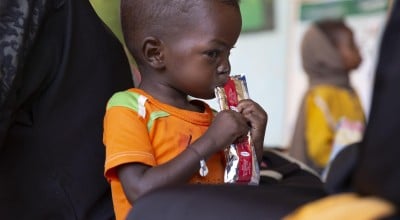
Read our 2024 annual report

Knowledge Hub
Millions will needlessly die if world doesn’t act urgently to end hunger'
In advance of Budget 2017, startling figures have emerged today on the fight against global hunger. A shocking 795 million people, 173 times the population of Ireland, are facing hunger every day according to the Global Hunger Index report jointly released by Concern Worldwide, The International Food Policy Research Institute (IFPRI) and German NGO Welthungerhilfe.
The report describes the slow decline in hunger levels worldwide since 1992 and warns that hunger will not be eliminated by the globally agreed goal of 2030 without strong international leadership. Up to 50 countries – including Yemen, Haiti, Pakistan, Zimbabwe, and Afghanistan – will still have “moderate” to “alarming” hunger scores in the year 2030, appallingly short of the crucial goal to end hunger by that year.
Speaking at the launch of the report, Dominic MacSorley, CEO of Concern Worldwide said today:
"Whilst the world has made progress in the fight against hunger there are still 795 million people condemned to facing hunger every day of their lives. According to the United Nations, around 21,000 people die every day of hunger or hunger related causes, which means it would take just 219 days for hunger to wipe out the entire population of Ireland, that’s a sobering thought.
“Concern staff in countries like Niger have told me harrowing stories of parents having to choose, which child gets to eat the one meal they have to offer them a day. Other families are surviving on just a bowl of porridge a day while others, worse off, are going hungry for up to 10 days. These levels of hunger and malnutrition are just not unacceptable in the 21st century, it is immoral and shameful.
“Resources like the Global Hunger Index provide us with a critical insight into the scale of the global hunger crisis and points to successes such as Ghana, where huge advances have been made in tackling hunger through strong political leadership, transformation of food systems, community engagement and focussing on the most vulnerable.
“Agenda 2030 provides us with the ambition and commitment to reach zero hunger. We have the technology, knowledge and resources to achieve that vision. What is missing is both the urgency and the political will to turn commitments into action.”
The Central African Republic, Chad, and Zambia had the highest levels of hunger in the report. Seven countries had “alarming” levels of hunger, while 43 countries including India, Nigeria, and Indonesia had “serious” hunger levels.
Positively, the study outlined some bright spots in the fight to end world hunger. The level of hunger in developing countries as measured by the Global Hunger Index has fallen by 29 per cent since 2000. Twenty countries, including Rwanda, Cambodia, and Myanmar, have all reduced their GHI scores by over 50 per cent each since 2000.
However, declines in average hunger levels across regions or individual countries do not tell the whole story. Even within regions and countries that have broadly reduced hunger to low levels, lagging areas are leaving millions still hungry, and demonstrate the need to target solutions to communities facing the greatest need.
Haiti, which is recovering from the effects of Hurricane Matthew, has the fourth highest GHI score at an “alarming” 36.9, despite the Latin America region having the lowest regional GHI score in the developing world.
Worryingly, data could not be collected for 13 countries – 10 of which the authors say are countries of significant concern for having high hunger levels, including Sudan, South Sudan, Somalia, and Syria. This means hunger levels are likely to be even higher across the world than the data is able to show.
The GHI, now in its 11th year, ranks countries based on four key indicators: undernourishment, child mortality, child wasting and child stunting. The 2016 report ranked 118 countries in the developing world, almost half of which have “serious” or “alarming” hunger levels.
Its score for the developing world as a whole is 21.3, which is in the low end of the “serious” category. Regionally, Africa South of the Sahara has the highest hunger level, followed closely by South Asia. Rounding out the top 10 countries with the highest levels of hunger after Central African Republic, Chad, and Zambia are: Haiti, Madagascar, Yemen, Sierra Leone, Afghanistan, Timor-Leste, and Niger.
The GHI also found that around half of the populations of Haiti, Zambia, and the Central African Republic is undernourished-the highest in the report. In Timor-Leste, Burundi, and Papua New Guinea, approximately half of children under five are too short due to nutritional deficiencies.
More information / interviews
Please contact Concern Communications Officer Catriona Loughran on 086 783 4846 or via email at catriona.loughran@concern.net.

Other ways to help
Corporate support
Is your company interested in working together for a common cause?
Fundraise for Concern
From mountain trekking to marathon running, cake sales to table quizzes, there are lots of ways you can support our work.
Buy a gift
With an extensive range of alternative gifts, we have something to suit everybody.
Leave a gift in your will
Leave the world a better place with a life-changing legacy.
Volunteer with Concern
The lots of ways to get involved with our work as a volunteer
School fundraising
Without the generous support from schools, we wouldn't be able to do the work that we do.




